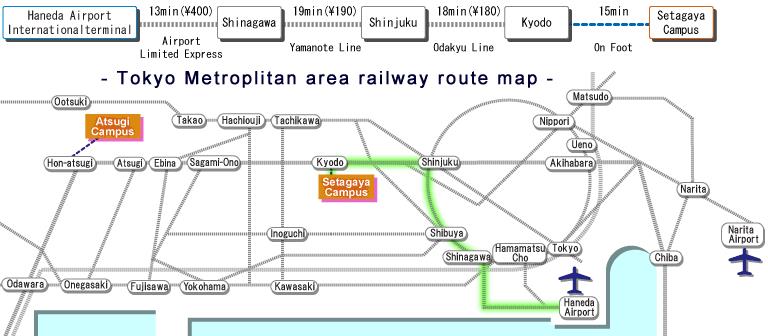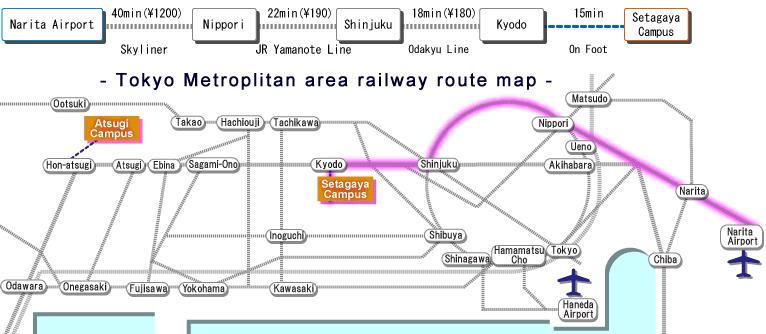Transportation
Transportation to Setagaya Campus of Tokyo University of Agriculture
1. From Haneda Airport To Setagaya Campus

2. From Narita Airport To Setagaya Campus

3. Bus Stops Near Setagaya Campus of Tokyo University of Agriculture
(1). Nodai Seijin Goakko Mae (Bus No.s: Shibu 23; To11; Yo01)
(2). Sakuragaoka Chugaku (Bus No.s: Shibu 23; To11; Yo01)
(3). Sakuragaoka 3 Chome (Bus No.: To12; Yo06)
(4). Nodai Mae (Bus No.s: Shibu 22; Shibu 23; To11; 渋24 and 渋26 )
General Transportation Information in Japan
Japan's peerless public transportation shuttles you through sprawling cities and quaint villages at break-neck speed and with pinpoint punctuality. From the sleek shinkansen to the humble local train, timetables are followed religiously with a service you can quite literally set your watch by. Local buses and long-distance coaches follow suit and the army of taxis that patrol the streets are spotlessly clean and unreservedly trustworthy. In addition to this unrivaled service, a vast array of discount passes and travel cards are available offering wallet-friendly options to allow you to travel farther and wider with the upmost convenience and ease.
Air Travel
Most visitors arrive in Japan by airplane, landing in one of four international airports—Narita or Haneda in Tokyo, Central Japan in Nagoya, and Kansai in Osaka. Over 50 domestic airports connect all of Japan’s islands and offer a fast and efficient way to cover great distances quickly.
Trains
Japan’s four major islands—Honshu, Hokkaido, Kyushu, and Shikoku—are covered by an extensive and reliable network of railways. Trains are a very convenient way for visitors to travel around Japan, especially in conjunction with the Japan Rail Pass (several options are available). About 70 percent of Japan’s railway network is owned and operated by the Japan Railways (JR), while the remaining 30 percent belongs to dozens of other private railway companies, especially in and around metropolitan areas. Japan’s high-speed trains (bullet trains) are called shinkansen and are operated by Japan Railways.
If you are planning to use the shinkansen to travel throughout Japan, doing some research into how to buy train tickets (JR East, JR West, JR Central, JR Hokkaido, JR Kyushu) will make the process smoother.
Note that the JR Rail Pass cannot be used on this particular train.
• Japan Railways (JR)
Japan's leading railway company, Japan Railways (JR), has an elaborate and well-established network of trains throughout the country. From scenic local trains to the super express shinkansen, if you are traveling on rail in Japan, the chances are it will be with JR. About 70 percent of Japan’s railway network is owned and operated by the Japan Railways (JR), while the remaining 30 percent belongs to dozens of other private railway companies, especially in and around metropolitan areas. Japan’s high-speed trains (bullet trains) are called shinkansen and are operated by Japan Railways.
• Shinkansen (Bullet Train)
The shinkansen rockets down a number of different routes across Japan. The Tokaido-Sanyo Shinkansen links Tokyo and Hakata. The Tohoku Shinkansen links Tokyo and Shin-Aomori; the Johetsu Shinkansen links Tokyo and Niigata; the Nagano Shinkansen links Tokyo and Nagano; and the Kyushu Shinkansen in Kyushu presently links Shinyatsushiro (Kumamoto Prefecture) and Kagoshima Chuo (Kagoshima Prefecture). There are three types of seats: Non-reserved seats, Reserved seats, and Green Car seats.
• Local Railways
A fun way to travel into local Japan, find out the events, recommended spots and original tours produced by each railway, and make use of the free Wi-Fi.
Subway
Major advancements are being made in providing multi-language support on Japan's subway systems making it much easier to get around. Ticket machines, station names, as well as maps and guides of the subway and the local area are often provided in a number of languages. For ease of travel and peace of mind, research the subway system in the area you will be traveling in. Many of them have sites in English. If you plan to travel exclusively by subway, research the various passes available to ride economically.
Fukuoka Subway Network
Kobe Subway Network
Kyoto Subway Network
Nagoya Subway Network
Osaka Subway Network Sapporo Subway Network
Sendai Subway Network
Tokyo Subway Network(Tokyo Metro Lines)
Tokyo Subway Network (Toei Lines)
Yokohama Subway Network
Bus
Bus services are available throughout Japan, and can often be a very convenient alternative to trains—especially when traveling in more local areas. Using buses in Japan can be intimidating to foreign tourists (and even Japanese people), because there are different ticketing systems depending on the company, and recognizing the stop where you need to get off can be challenging. While some bus companies do a good job at providing English signage, timetables, and announcements, many buses lack any English information, altogether.
Riding a metro bus
• For buses with two doors, you typically board through the rear door.
• Upon boarding, take a ticket from the automatic dispenser. Hold onto this as it is needed when you get off to determine your fare.
• Bus stops are shown near the front of the bus with accompanying fare information for each stop.
• To get off the bus, press one of the many buttons on the wall. This alerts the driver and other passengers that the bus will be stopping at the next bus stop.
• When you get off the bus, put your ticket with the proper fare in the box next to the driver. If you don’t have change, there is usually a change machine for bills and coins. The exact fare is necessary, and if you put more, you will not receive change.
Note that in Tokyo, Kyoto and other large urban areas, many routes have a flat fare, which is paid upon boarding the bus. In this case, passengers usually board from the front and pay immediately.
Recently, many bus companies have begun accepting contactless smart cards (Suica, Passmo, etc.), which are pre-paid. When riding a bus equipped with this type of system, simply touch the sensor upon boarding, then touch again when getting off. The bus fare is automatically deducted from the card.
Taxi
In Japan’s large cities, taxis are an expensive and unnecessary alternative to the efficient public transportation system. However, taxis are often the only way of getting around once trains and buses stop operating around midnight; this results in a sudden increase in their demand, especially on Friday and Saturday nights, when long lines and waiting times at taxi stands at train stations are not uncommon. In smaller cities, the countryside, and in Kyoto, public transportation tends to be less convenient, thus taking a taxi from the nearest train station to your destination can be a good alternative. If you travel in groups of three or more people, taxis can also be an economical option if you are traveling a short distance.
Many taxis accept payment by credit card. Stickers on the door often indicate accepted payment methods. When paying in cash, try to avoid paying small amounts with large bills. Tipping is not necessary in Japan.
Ship
Consisting of several thousand islands, Japan is naturally home to an extensive network of ferry routes. Japan’s four main islands (Honshu, Hokkaido, Kyushu and Shikoku) are connected by bridges and tunnels, but many smaller islands can only be reached by ship.